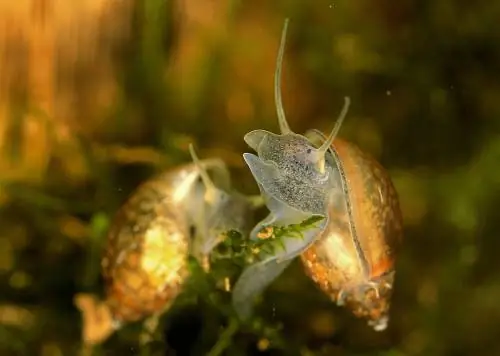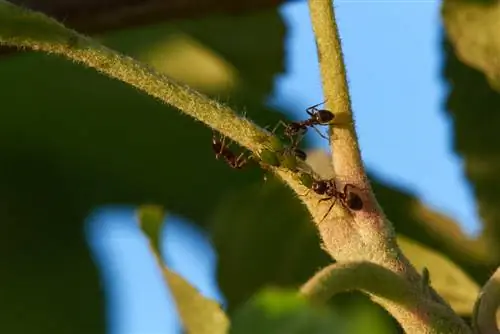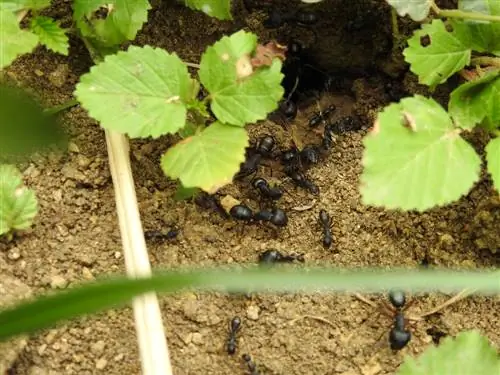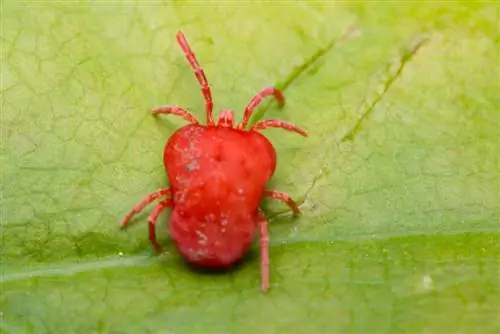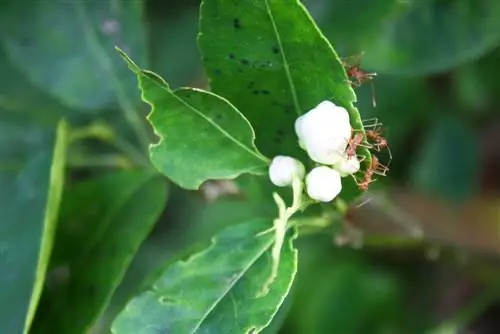- Author admin [email protected].
- Public 2023-12-16 16:46.
- Last modified 2025-01-23 11:22.
It is not uncommon for aquarium owners to be surprised by spontaneous new residents. They sneak in and enjoy the optimal living conditions in the new environment. Bladder snails are one of these animals. Contrary to what was expected, the aquatic organisms do not cause any harm.
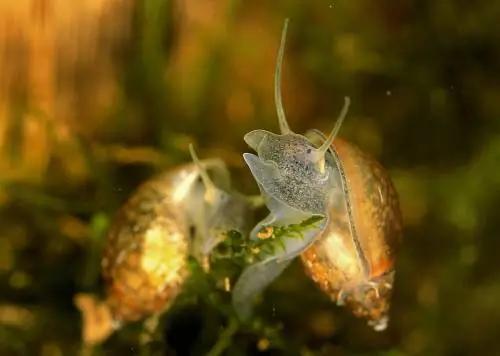
Are bladder snails harmful or beneficial in the aquarium?
Bladder snails are harmless, useful aquarium inhabitants that are often introduced through aquatic plants. They clean the aquarium by eating algae and maintaining water quality. They pose no threat to plants, fish or fish eggs and can survive in various water conditions.
Profile
Bladder snails are a family within the water lung snails. There are around 80 species worldwide, three of which are native to Central Europe and one was introduced from North America. In aquaristics, bladder snails are considered a spontaneous companion fauna that are introduced through new aquatic plants, decorations or fresh substrate. From a biological point of view, they are an enrichment for the ecosystem because they break down organic substances more quickly.
Good to know:
- Shell is formed from dissolved lime in the surrounding water
- at low pH the shell dissolves
- Addition of carbon dioxide promotes shell dissolution
- Snails are no longer able to survive
Features
Bubble snails have a transparent and shiny shell with a smooth surface and can reach a size of up to 12 millimeters. However, they usually remain significantly smaller. The snail shell always curves to the left and tapers to a point or blunt. Through this bulbous and horn-colored housing, the light-dotted sheath fabric is clearly visible. This gives bubble snails the appearance of bubble-like golden dots, which is why they get their name. Despite the small wall thickness, the snail shell is comparatively stable.
Special features:
- pointed and narrow foot
- long, thin antennae
- Eyes are located at the base of the antennae
Excursus
This is how bladder snails breathe
Bubble snails have an air bubble that they always carry with them in their shell. This oxygen reserve is occasionally replenished at the surface of the water. The lung function is taken over by the adjacent mantle tissue, which has a strong blood supply. Species such as the pointed bladder snail have a finger-shaped fringe that extends beyond the edge of the shell and functions as a secondary gill. With this organ the bladder snail can absorb additional oxygen from the water.
Locomotion
The snails can reach considerable speeds in the water. They only need ten seconds to cover one centimeter. They leave behind a thin film of mucus, which is secreted by a gland and covers the soil. When the snails glide through the water without contact with the bottom, they drag the slime behind them in threads. These almost invisible spider threads can expand into a complex system of tracks when the water current is low. The snails can clamber along these threads and return to the starting point.
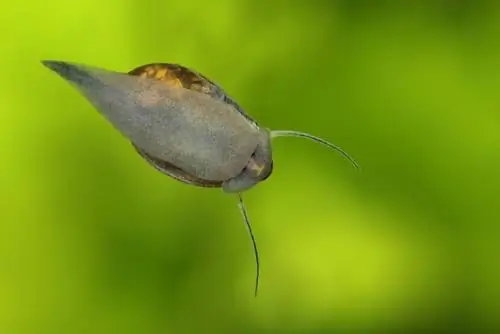
Bubble snails are amazingly fast
Protection from enemies
When threatened, land snails can retreat into their shell and close it with a lid. Bladder snails do not have such a closure and must protect themselves in other ways. They are able to expel air from their respiratory system. This makes the snail heavier than the water and quickly sinks to the bottom of the water, where it is safe from predators.
Waterlung Snails
The small bladder snail is one of the freshwater inhabitants that breathes with the help of lungs. Their gills have degenerated so that the animals can only absorb oxygen from the air. Therefore, bladder snails crawl to the surface of the water. Mud snails, which are sometimes confused with bladder snails, and ramshorn snails also breathe in this way.
| Sensor | Housing | Food | |
|---|---|---|---|
| Mud Snails | triangular | rightwinding | occasionally live plants |
| ramshorn snails | thickened | rolled up in one layer | Algae deposits, remains of dead plant parts |
| Bubble Snails | string-like, long | left-handed, brightly spotted | Algae growth, biofilms and residues |
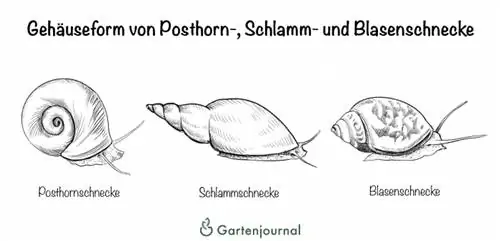
Bubble snails in the aquarium
Bladder snails often enter the aquarium through purchased aquatic plants, where they multiply quickly under optimal conditions. Contrary to popular belief, the species are completely harmless and can be bred together with various organisms. Bladder snails are not a threat to shrimp and fish. However, some shrimps eat the spawn of bladder snails.
Useful
Bubble snails cannot ensure that the aquarium remains completely free of algae. Nevertheless, they are a valuable aid in cleaning. They maintain water quality by controlling the algae population. They eat fish excrement and leftover fish food that has sunk to the bottom.
The bladder snail thereby deprives many bacteria of an important source of life and thus reduces the germ density in the water. The fish's immune system must be able to withstand a lower germ pressure so that the organisms can live in clean water.
Bubble snails are the underwater he alth police. They utilize both spoiled and half-digested leftovers.
Lifestyle and development
Bubble snails are active during the day and night and are extremely adaptable. They can cope with both warm and cooler temperatures and also inhabit polluted waters with a high pH value. The snails are hermaphrodite animals that do not necessarily need a partner to reproduce. Therefore, one introduced snail is enough to establish a small population. Nothing is known about the life expectancy of a snail.
Mating
If there are enough conspecifics available, the snails will look for a mating partner. The individuals take on either the male or female role. Often several animals can be observed mating in a long chain. During mating, a snail crawls onto the partner's shell and protrudes the male sexual organ. The lower animal acts as a female. After a few minutes the act is completed and the female drives away her partner with beating movements.

Egg laying
Bladder snails lay their eggs in the form of elongated masses. This so-called spawning ball is slightly curved and feels soft and jelly-like under pressure. A bladder snail can produce between three and 40 spawn balls. They are deposited on plant parts and left to their own devices. The eggs stand out as bright dots from the mass, which consists of several levels. The spawn is almost invisible and can only be seen against a black background or when the light falls at an angle.
Development
At a water temperature of 24 degrees Celsius, embryo development takes ten days. The tiny young snails usually leave the spawn after eight to 14 days to go looking for food. There is no parental brood care.
Food
Bladderfish feed primarily on dead plant parts in the aquarium. They get their food from unused or half-digested remains of organic material, including fish excrement or sunken fish food. They do not eat higher plants, but rather eat the growth of lower plants such as pebbles and green algae. Your rasp tongue is unable to break down the tissue of he althy plants.
Mistakes cleared up:
- Plant killer: does not eat plants that are alive
- spawn robber: Bladder snail doesn't attack fish spawn
- Window cleaner: tiny mouths cannot get glass completely free of algae
Determine species
Of the 80 species worldwide, there are three that are native to Central Europe. These species can be distinguished from one another based on their appearance. The water often also provides clues to the species, although some bladder snails are adaptable and can tolerate suboptimal conditions.
| habitat | Appearance | Housing | ||
|---|---|---|---|---|
| Pointy bubble snail | no demands on water quality | yellowish horn colored | six turns | |
| Bubble snail | clear, plant-rich still and flowing waters | yellow-brown to black-blue | four turns | |
| Moss bubble snail | plant-rich ditches, ponds, moors | yellowish to reddish-brown | slim |
Breeding bladder snails
There are some species of fish such as puffer fish or paradise fish that prefer to feed on snails. Zebra loaches and black loaches are also known to eat snails and prey on snails and spawn. If you keep such fish, you can supply them from your own snail farm.

Vessel and feeding
A container with a capacity of five liters is a good start for breeding bladder snails. You can feed the animals slices of cucumber and raw potatoes. Occasionally add a pinch of fish food to the water. Bladder snails like to accept fish food tablets that are actually intended for ground fish. You can also throw dead flies into the water. This approach food is a protein-rich treat.
Planting and location
Put some aquatic plants in the container to optimize the living conditions. Waterweed is enough to make bladder snails feel comfortable. Place the container in a bright location to encourage algae to develop. These cover the aquatic plants and offer the hatched larvae a good source of food.
Care and cleaning
The water should be changed occasionally. Make sure that the water hardness is not too low. Normally tap water is sufficient. If you are unsure, you can crumble the shell of a chicken egg and add it to the water. If you place the vessel in living rooms with normal room temperature, you do not need to heat additionally. However, temperatures between 22 and 25 degrees Celsius accelerate the reproduction and development of the larvae.
Enemies and Dangers
When bladder snails reproduce intensively, you should check the conditions. A strong population development indicates a high nutrient input. Excessively large amounts of fish food encourage uncontrolled reproduction because the natural conditions are optimal for the bladder snail.
Tip
Feed more sparingly and make sure that no fish food sinks to the bottom. When you collect bladder snails from the aquarium, more and more unused remains remain on the bottom
Parasites
Bladder snails are used as intermediate hosts by parasitic flukes. The approximately one millimeter long zecariae of the genus Trichobilharzia spread through duck droppings. The hatching larvae settle in the snails and presumably infect other hosts before the worms, which live freely in the water, bore through the ducks' skin again.
Robber tower lid snails
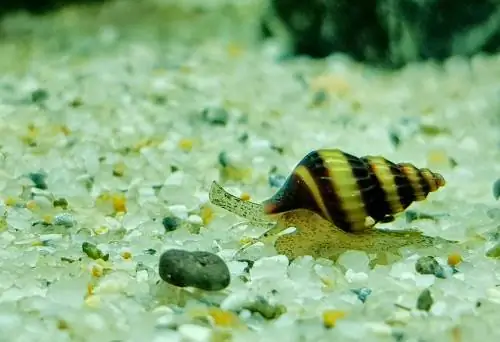
Robber tower snails eat bladder snails
The carnivorous snail is a useful aquarium inhabitant that lives in both soft and hard water. With its striped housing, the species is a visual enrichment. The animals have separate sexes and are less prone to mass reproduction. After eradicating the bladder snails, you can feed predatory tower snails with fish food.
Apple snails
The species come from the tropics, where they live in swampy waters. They prefer a water temperature of 18 to 28 degrees Celsius. Apple snails use the spawn of other snails as a source of protein and will not stop at live snails if they are deficient, even though they eat a predominantly plant-based diet.
Copper
Sometimes it is necessary to use copper-containing medications against leeches, parasites or planarians. In large quantities, copper causes the death of bladder snails. However, low concentrations are not bad and are even beneficial because the snails need copper as a trace element. Plant fertilizers containing copper are harmless in most cases.
Tip
Stay away from attack by a fish species. As soon as it has eradicated the bladder snail, it lacks the nutritional basis and shows deficiency symptoms.
Frequently asked questions
What are bladder snails?
Bladder snails are aquatic snails and live in fresh water. What is typical is their left-handed casing, which ends in a pointed or blunt manner. Bladder snails do have secondary gills with which they can extract oxygen from the water. Nevertheless, they occasionally have to go to the surface of the water to fill up their gas bubble in their shell. They absorb the oxygen through the mantle tissue.
Are bladder snails harmful?
Many aquarium owners are afraid of the bladder snail. They worry about their aquatic plants and the spawn of other creatures. But bladder snails are completely harmless and anything but harmful. They prove to be extremely useful because they are considered indicator organisms and show errors in aquarium care. The snails play an important role as regulators because they utilize excess food and dead remains.
Why do bladder snails reproduce en masse?
The snails react extremely to the conditions in their habitat. If there is a surplus of food, the animals reproduce in large numbers. If food resources dwindle, the animals stop mating activities. You should only add as much food to the water as the fish can eat. Make sure that no large amounts sink to the ground.
Can you breed bladder snails?
The animals are available to buy in stores, as many aquarium owners use bladder snails as food for their fish. Bladder snails can be bred in the aquarium using simple means. During the summer months you can put them in the garden pond. Bladder snails are tolerant and can tolerate cooler temperatures. The optimal water temperature is between 22 and 25 degrees Celsius. Sea water is not suitable for breeding as the animals live in fresh water.
Where do bladder snails live?
Many of the approximately 80 species of bladder snails were transported from their original ranges, allowing them to spread widely. The climatic conditions represent the limit of their spread. Bladder snails live in stagnant or slow-flowing water. They prefer dense vegetation because this serves as a source of food, hiding place and spawning place. Four species are known in Germany, with one species being introduced from North America.

